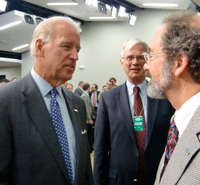Third-generation DNA sequencing technologies to be developed by ASU

Stuart Lindsay, a researcher at ASU's Biodesign Institute, has been awarded a new three-year $860,000 grant to continue his team’s innovative efforts to develop low-cost DNA sequencing aimed at becoming a routine part of medical care.
Lindsay was one of 10 recipients in the country to receive funding from the National Human Genome Research Institute (NHGRI), part of the National Institutes of Health, to spur the development of a third generation of DNA sequencing technologies.
Since 2004, the NHGRI has launched initiatives to accelerate the development of sequencing technologies and reduce the costs of genome sequencing. Last year, the NHGRI research program goal of producing high-quality genome sequence of 3 billion base pairs - the amount of DNA found in humans and other mammals - fell below $100,000. The cost to sequence a human genome has now dipped below $40,000.
The new grants will develop revolutionary technologies that would make it possible to sequence a genome for $1,000. Current technologies can only read about 1,000 chemical letters of the 3-billion-long human DNA chain at a time.
“We have discovered a new technique that uses a simple reagent to measure distinct signals that can be generated to distinguish the ‘A, G, C and T’ chemical bases that are the basic building blocks of DNA,” Lindsay said. “Now, we will try to read short sequences of DNA using this technology, then make a device to read even longer stretches, perhaps even thousand or hundred of thousands of bases at a time.”
Lindsay is an ASU Regents’ Professor in physics and chemistry, the Edward and Nadine Carson Presidential Chair in Physics and director of the Center for Single Molecule Biophysics at the Biodesign Institute. His research team, which includes Peiming Zhang, Jin He and Otto Sankey, has received more than $4 million in awards from the NHGRI for their next-generation DNA sequencing technology research.
Recently, Lindsay was one of many outstanding scientists honored in a Washington D.C., gathering held by Vice President Joe Biden to coincide with the release of the Recovery Act Innovation Report. As part of the American Recovery & Reinvestment Act of 2009 (“Recovery Act” or “ARRA”), the National Institutes of Health established a new program titled Research and Research Infrastructure “Grand Opportunities,” or the “GO” grants program. Lindsay’s two-year, $1.7 million project, funded by the National Human Genome Research Institute (NHGRI), supported work at ASU’s Biodesign Institute to boost research on rapid DNA sequencing technology.
Lindsay’s research team utilizes nanotechnology at the core of its sequencing efforts, building tiny, carbon nanotubes that allow for vast stretches of DNA sequence information to be read in a single pass. As the bases pass through the hole in the tube, a quantum effect wrinkle called electron tunneling occurs, and a small difference in the electrical current can be measured to distinguish the chemical bases from each other.
“With this continued effort, we will identify improvements needed to increase the readout efficiency and also develop criteria for design of a nanopore sequencing system equipped with tunneling electrodes,” Lindsay said. “The reagents developed during the course of this research will be made available to other research groups developing nanopore sequencers that use electron tunneling as the readout.”
The NHGRI identified the development of next-generation technologies that can sequence a human genome for $1,000 or less as its Recovery Act Signature Project. In recent years, ASU has had several ongoing DNA sequencing projects funded by the NHGRI.
“We are very thankful for the NHGRI’s support to drive innovation in DNA sequencing technology and humbled in the recognition of our efforts by the White House,” Lindsay said. “Our ultimate goal is to simplify DNA sequencing to revolutionize medicine like the invention of the transistor changed electronics.”
Provided by Arizona State University

















